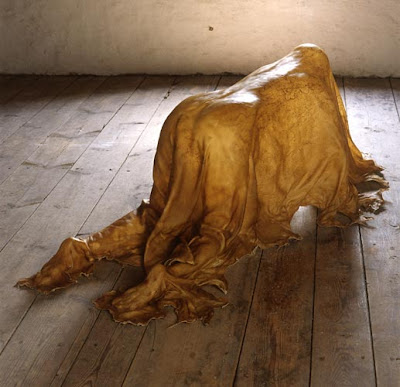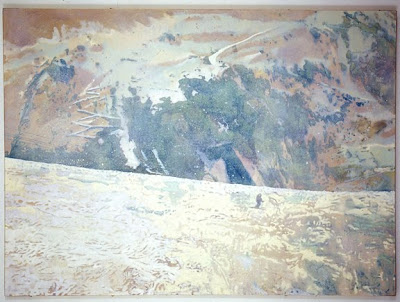a comparison of
Karol Radziszewski's
To Pee In a Bun and
Nicolas Grospierre's
KunstkameraThe two recently* opened exhibitions at the main two contemporary art centers in Warsaw –
Zachęta and the
Contemporary Art Center – have some clear similarities.
Both exhibitions are witty, explicit dialogues with art history. They both play on the distance that separates contemporary art conventions from what has been somewhat recklessly left behind. Radziszewski exhibits works hidden in the depths of the national gallery’s archives. Some are excruciating to look at, others are curious discoveries or brilliant works. Grospierre goes back to the format of the Kunstkammer and does what he does best – plays with it.
They both focus on the structure of an exhibition, and make it an essential aspect, a sort of a meta-work which goes far beyond the classical idea of curator and uses the ambiguity of this function to the utmost. It is impossible to say where the curator’s role stops and the artist’s begins. This goes far beyond the inclusion of the curator’s own works in the exhibition, or his manipulation of the showing. We never know when the appreciation of the shown works is genuine, and when it is ironic. And because of the artists’ works being part of the selection, the self-irony is, as always, disarming.
However, each artist enacts the role of contemporary art trickster in a different way. Beyond questions of scale, budget and context of production, the two exhibitions are at two opposite sides of an old aesthetic debate. They present two different approaches to the question of value in aesthetics. But first, let me give you a brief description of each of the exhibitions.
Karol Radziszewski’s exhibition
To Pee in a Bun, is grandiose. It is a personal take on the collection of Poland’s most renowned and respected public gallery of Modern Art (charmingly called The Encouragement for Fine Art).


In it, he acts “merely” as curator, and also as one of the numerous exhibited artists. Here is what the curator had to say in a conversation with himself as artist :
C: Curators are the ones who make the artists conscious of
‘what’ they have created and ‘why’; often, they also manipulate the
works being displayed, creating their own narratives from pre-existing
works, at the same time disregarding their previous context.
A: Like you did in this exhibition?
C: Yes. (laughs)
A: Why?
C: I treat other artists’ works as elements of a larger whole, like
tubes of paint, from which I have to squeeze out colours in order
to paint one complex painting.
A: That’s a very colourful metaphor . . .
C: Thank you.
We could say that Nicolas Grospierre creates a similar procedure of remixing curator and artist when in the
Kunstkamera installation, (which is the size of one of the smaller rooms in Radziszewski’s exhibition), he hangs mainly pictures of objects and photos created by other people, and signs the whole as his piece.

Yet the vectors, here, point elsewhere. Instead of spreading the works and opening, if not exploding, them, he seems to move inwards, closing the space and folding it yet again. Upon entering the "room", we discover a game of images reproducing images reproducing the same space with other images. The game goes on, like a play with mirrors, ad infinitum. The "meaning" is still ambiguous - yet it concentrates, thickens, moves toward inhabiting the space instead of abandoning it.

So what does all of this have to do with philosophical debates?
In an article published in 1936,
Stanisław Ossowski, one of Poland’s most notable thinkers from the famous
Lvov-Warsaw school of thought, argued against aesthetics understood as the “construction of value systems”. The generalizing of arbitrary aesthetic feelings and opinions to the level of theory should, in his opinion, give way to a sociological perspective on art and the aesthetic, one which would embrace the richness of opinions and points of view instead of imposing them.
This bold proposal was answered the same year by another great mind,
Henryk Elzenberg, who argued that no matter how weak and prone to error, our aesthetic judgments remain anchored in value systems that can and should be discussed – as we cannot speak of aesthetics without referring to value, and values are open to discussion.
To put it bluntly: in Radziszewski’s exhibition I see Ossowski’s distancing from aesthetics as a system of values, while Grospierre’s installation follows Elzenberg’s ideals.
These are really two different ways of approaching the world.
Ossowski claims that any discussion about aesthetic values comes down to a power struggle. And this overpowering does not go through a sharing of enthusiasm or disgust, but goes through the attribution of value. Why? Elzenberg explains:
Apparently [the value-based aestheticist] lacks qualifications: he does not have the authority, or the suggestive strength, or the capacity to contaminate others with his feeling. And he is overfilled with the will to rule. Thus, he tries to convince the victim that if this victim feels the same things he does, the victim will be right, he will be somehow objectively correct; and he will be wrong if he dares otherwise.
Hence the need for distance.
It seems Radziszewski claims it on every single step. On one hand, his collection is a moving away from an engaged position, it is rather a questioning of our aesthetic values, of their ever-astounding relativity and apparent insignificance. Who are we to say that this is pretty, and this isn’t? How are we to judge the works that a mere 30 years ago were judged outstanding, while today they’re hidden away in a museum cellar?

On the other hand though, Radziszewski’s approach differs from Ossowski’s philosophy in one respect: being an artist, and not a social scientist, he does not feel the need to eradicate the position of power. To the contrary, he exposes it by exploring it to the fullest. Why bring a porn film into the gallery? Because it’s shocking, and attracts audiences. The aestheticist’s position allows him to create values arbitrarily:
A: You’re a curator — does that mean power?
C: Absolute power! (laughs)
A: Most people believe curators are unfulfilled artists.
C: I think that does hold true for me. Besides, to quote Krasiński
yet again, ‘Art is too serious a business to be left in artists’ hands.’

Grospierre is at a very different point. He does not feel the necessity to question everything – art history has done it sufficiently. Instead, he looks for ways of exploring the place of art today while not undoing it all yet again. Romantic? Certainly. It is a self-ironic romanticism, one that takes great effort in presenting itself as distanced and eye-winking. No wonder Grospierre cites Italo Calvino and Borges: this is the romantic universe that leads the battle for saving beauty. It is not, however, an intuitive aesthetic experience kind of beauty. The
Kunstkamera is all about unending layers of initiation. It is a dive into the possibility of image, the possibility of the reflection of things, of some sort of hidden and evolving harmony between the object and the subject.

It reminds one of Heidegger’s conception of art as a window to some other realm we can in no other way describe. Here, this realm always crosses first an image of the reality we know – and so, we never know if this is the level of work-of-art, or it is only a description thereof. Fittingly, the exhibition flyer (a photocopy with clear photocopy marks) explains it all, and more. It seems to impose its vision of the work before we even get to see it.
Take, for instance, the “Trophies” section.
Trophies represent four dog muzzles, belonging to the commonest of mongrels. Bolek, Majka, Eryk and Gucio are four doggies among thousands. In the old Wunderkammer we would find extraordinary or unique natural objects: the horn of a unicorn, huge crystals, stuffed reptiles and other monstrosities. The idea was to show nature in the most surprising forms. Today the world seems devoid of the mysteries and much simpler than in the sixteenth century: the monsters disappeared from biology books. Might it be that the world is less poetic, more prosaic? I don’t think so. Even if science discovered many of nature’s secrets, for me poetry and mystery are still present in nature – we can find them in the most common species, such as house dogs.

The two positions can be called “metaphisical” and “positivist”. Elzenberg’s metaphisicist is
quite aware that there are hundreds of traps on his way; that his individual chances of error are bigger than his chances of winning; he feels that his results are to the highest degree uncertain, endangered by others’ critique and by his own. He feels the constant risk. Yet this risk is also his joy, since, as a psychological type, he has in him – and indeed needs to have – a little bit of a man of adventure and his attitude towards the “positivist” is somewhat like the attitude of a sailor that knows he can drown, towards the landlubber, who has no such fiercely unpleasant risk awaiting. It gives him a sort of satisfaction, but that is not what decides about his behavior in terms of acquiring knowledge; the decisive factor is that he does not want to drown. And that is why he is first and foremost careful. The “Metaphisicist” – or rather, to put it in more serious terms, the valuing aestheticist – knows well that his subject is unclear and unattainable and that what he discovers in it flees any adequate descriptions. Thus, although he is a sui generis racionalist to start off, it is nonetheless easy to discover a trait in him that is the contrary of a strict rationalism: the tendency to treat concepts and judgments as merely a type of highly uncertain symbols of a reality that resists human thought. Thus, he will not suggest that the chiaroscuro in which he sees the thing is full light, nor will he bond himself till death due him part with this or that linguistic formula or even this or that discursive elaboration of his intuition. He – yes he! - has something in him of the spirit of empiricism, as he understands his moving into the subject as a multiplicity of attempts and returns, as the entering in contact, as a progressive bonding with reality. Hence, he has the quality of being critical towards his own achievements, he consciously softens the edges of his statements, and is ready for changes and corrections, and, generally speaking, is moderate and more moderate even.
So do you believe in magic? In the aesthetic wonder of art, that keeps evolving beyond all expectations, that is in some strange way always related to beauty, and maintains some sort of objective common ground, some platform of shared values?
Or did the whole building of aesthetics collapse, leaving us in a void where any new creation of value is so easily ridiculed, art may at best be looked from a great distance, with an ironic, witty, sensitive yet unaffirming stance?
I must say I prefer Grospierre's installation: it's discursive and communicative, inquiring and playful, desperately searching for beauty, or maybe: aiming at beauty. This is a work of a believer. And although I'm not exactly a believer, I can repeat after one of my favorite characters,
Samuel Hamilton:
I don't really believe in it save that it works.
*It took me some time to write this... and tomorrow is the last day of Kunstkamera! Hurry if you want to see it.



































